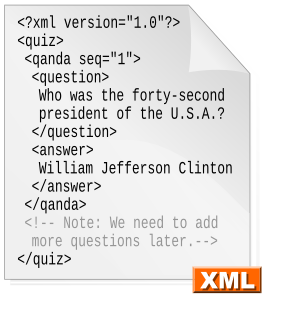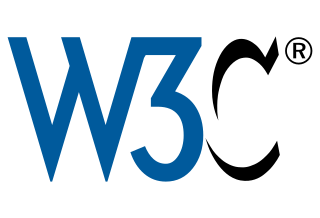
Extensible Markup Language (XML) is a markup language that defines a set of rules for encoding documents in a format that is both human-readable and machine-readable. The W3C's XML 1.0 Specification and several other related specifications—all of them free open standards—define XML.
In computing, the Open Geospatial Consortium Web Feature Service (WFS) Interface Standard provides an interface allowing requests for geographical features across the web using platform-independent calls. One can think of geographical features as the "source code" behind a map, whereas the WMS interface or online tiled mapping portals like Google Maps return only an image, which end-users cannot edit or spatially analyze. The XML-based GML furnishes the default payload-encoding for transporting geographic features, but other formats like shapefiles can also serve for transport. In early 2006 the OGC members approved the OpenGIS GML Simple Features Profile. This profile is designed both to increase interoperability between WFS servers and to improve the ease of implementation of the WFS standard.
Keyhole Markup Language (KML) is an XML notation for expressing geographic annotation and visualization within Internet-based, two-dimensional maps and three-dimensional Earth browsers. KML was developed for use with Google Earth, which was originally named Keyhole Earth Viewer. It was created by Keyhole, Inc, which was acquired by Google in 2004. KML became an international standard of the Open Geospatial Consortium in 2008. Google Earth was the first program able to view and graphically edit KML files. Other projects such as Marble have also started to develop KML support.

SPARQL is an RDF query language—that is, a semantic query language for databases—able to retrieve and manipulate data stored in Resource Description Framework (RDF) format. It was made a standard by the RDF Data Access Working Group (DAWG) of the World Wide Web Consortium, and is recognized as one of the key technologies of the semantic web. On 15 January 2008, SPARQL 1.0 became an official W3C Recommendation, and SPARQL 1.1 in March, 2013.
Catalog Service for the Web (CSW), sometimes seen as Catalog Service - Web, is a standard for exposing a catalogue of geospatial records in XML on the Internet. The catalogue is made up of records that describe geospatial data, geospatial services, and related resources.
GeoRSS is a specification for encoding location as part of a Web feed. (Web feeds are used to describe feeds of content, such as news articles, Audio blogs, video blogs and text blog entries. These web feeds are rendered by programs such as aggregators and web browsers.) The name "GeoRSS" is derived from RSS, the most known Web feed and syndication format.

Peter Baumann is a German computer scientist and professor at Jacobs University, Bremen, Germany, where he is head of the Large-Scale Scientific Information Systems research group in the Department of Computer Science and Electrical Engineering.
XPath is a query language for selecting nodes from an XML document. In addition, XPath may be used to compute values from the content of an XML document. XPath was defined by the World Wide Web Consortium (W3C).
Observations and Measurements, shortly known as O&M, is an international standard which defines a conceptual schema encoding for observations, and for features involved in sampling when making observations. While the O&M standard was developed in the context of geographic information systems, the model is derived from generic patterns proposed by Fowler and Odell, and is not limited to spatial information. O&M is one of the core standards in the OGC Sensor Web Enablement suite, providing the response model for Sensor Observation Service (SOS).
XQuery is a query and functional programming language that queries and transforms collections of structured and unstructured data, usually in the form of XML, text and with vendor-specific extensions for other data formats. The language is developed by the XML Query working group of the W3C. The work is closely coordinated with the development of XSLT by the XSL Working Group; the two groups share responsibility for XPath, which is a subset of XQuery.

An XML transformation language is a programming language designed specifically to transform an input XML document into an output document which satisfies some specific goal.
The Sensor Observation Service (SOS) is a web service to query real-time sensor data and sensor data time series and is part of the Sensor Web. The offered sensor data comprises descriptions of sensors themselves, which are encoded in the Sensor Model Language (SensorML), and the measured values in the Observations and Measurements encoding format. The web service as well as both file formats are open standards and specifications of the same name defined by the Open Geospatial Consortium (OGC).
WaterML is a technical standard and information model used to represent hydrological time series structures. The current version is WaterML 2.0, released an open standard of the Open Geospatial Consortium (OGC).

Array database management systems (DBMSs) provide database services specifically for arrays, that is: homogeneous collections of data items, sitting on a regular grid of one, two, or more dimensions. Often arrays are used to represent sensor, simulation, image, or statistics data. Such arrays tend to be Big Data, with single objects frequently ranging into Terabyte and soon Petabyte sizes; for example, today’s earth and space observation archives typically grow by Terabytes a day. Array databases aim at offering flexible, scalable storage and retrieval on this information category.








